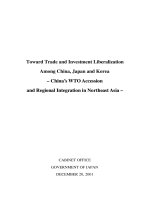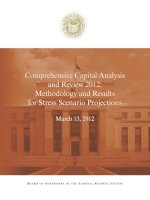STOCK ANALYSIS AND INVESTMENT pptx
Bạn đang xem bản rút gọn của tài liệu. Xem và tải ngay bản đầy đủ của tài liệu tại đây (998.11 KB, 76 trang )
CHAPTER EIGHT: STOCK ANALYSIS
AND INVESTMENT
06/08/2011 1
06/08/2011 2
INVESTMENT PROCESS
What is Value?
• In general, the value of an asset is the price
that a willing and able buyer pays to a willing
and able seller
• Note that if either the buyer or seller is not
both willing and able, then an offer does not
establish the value of the asset
06/08/2011 3
Several Kinds of “Value”
• There are several types of value, of which we are concerned
with four:
– Book Value – The carrying value on the balance sheet of the firm’s
equity (Total Assets less Total Liabilities)
– Tangible Book Value – Book value minus intangible assets (goodwill,
patents, etc)
– Market Value - The price of an asset as determined in a competitive
marketplace
– Intrinsic Value - The present value of the expected future cash flows
discounted at the decision maker’s required rate of return
06/08/2011 4
Determinants of Intrinsic Value
• There are two primary determinants of the intrinsic value of
an asset to an individual:
– The size and timing of the expected future cash flows.
– The individual’s required rate of return (this is determined by a
number of other factors such as risk/return preferences, returns on
competing investments, expected inflation, etc.).
• Note that the intrinsic value of an asset can be, and often is,
different for each individual (that’s what makes markets
work).
06/08/2011 5
Common Stock
• A share of common stock represents an ownership position in
the firm. Typically, the owners are entitled to vote on
important matters regarding the firm, to vote on the
membership of the board of directors, and (often) to receive
dividends.
• In the event of liquidation of the firm, the common
shareholders will receive a pro-rata share of the assets
remaining after the creditors (including employees) and
preferred stockholders have been paid off. If the liquidation is
bankruptcy related, the common shareholders typically
receive nothing, though it is possible that they may receive
some small amount.
06/08/2011 6
Common Stock Valuation
• As with any other security, the first step in valuing common
stocks is to determine the expected future cash flows.
• Finding the present values of these cash flows and adding
them together will give us the value:
• For a stock, there are two cash flows:
– Future dividend payments
– The future selling price
1
1
t
t
t
CS
k
CF
V
06/08/2011 7
Common Stock Valuation: An Example
• Assume that you are considering the purchase of a stock
which will pay dividends of $2 (D
1
) next year, and $2.16 (D
2
)
the following year. After receiving the second dividend, you
plan on selling the stock for $33.33. What is the intrinsic
value of this stock if your required return is 15%?
V
CS
2 00
1 15
216 3333
1 15
2857
1 2
.
.
. .
.
.
2.00
2.16
33.33
?
06/08/2011 8
Some Notes About Common Stock
• In valuing the common stock, we have made two
assumptions:
– We know the dividends that will be paid in the future.
– We know how much you will be able to sell the stock
for in the future.
• Both of these assumptions are unrealistic,
especially knowledge of the future selling price.
• Furthermore, suppose that you intend on holding
on to the stock for twenty years, the calculations
would be very tedious!
06/08/2011 9
Common Stock: Some Assumptions
• We cannot value common stock without making some
simplifying assumptions. These assumptions will define the
path of the future cash flows so that we can derive a present
value formula to value the cash flows.
• If we make the following assumptions, we can derive a simple
model for common stock valuation:
– Your holding period is infinite (i.e., you will never sell the stock so you
don’t have to worry about forecasting a future selling price).
– The dividends will grow at a constant rate forever.
• Note that the second assumption allows us to predict every
future dividend, as long as we know the most recent dividend
and the growth rate.
06/08/2011 10
The Dividend Discount Model (DDM)
• With these assumptions, we can derive a
model that is variously known as the Dividend
Discount Model, the Constant Growth Model,
or the Gordon Model:
• This model gives us the present value of an
infinite stream of dividends that are growing
at a constant rate.
V
D g
k g
D
k g
CS
CS CS
0
1
1
06/08/2011 11
Estimating the DDM Inputs
• The DDM requires us to estimate the dividend growth rate
and the required rate of return.
• The dividend growth rate can be estimated in three ways:
– Use the historical growth rate and assume it will continue
– Use the equation: g = br
– Generate your own forecast with whatever method seems appropriate
• The required return is often estimated by using the CAPM: k
i
=
k
rf
+ b
i
(k
m
– k
rf
) or some other asset pricing model.
06/08/2011 12
The DDM: An Example
• Recall our previous example in which the
dividends were growing at 8% per year, and
your required return was 15%.
• The value of the stock must be (D
0
= 1.85):
• Note that this is exactly the same value that
we got earlier, but we didn’t have to use an
assumed future selling price.
V
CS
185 1 08
15 08
2 00
015 08
2857
. .
. .
.
. .
.
06/08/2011 13
The DDM Extended
• There is no reason that we can’t use the DDM
at any point in time.
• For example, we might want to calculate the
price that a stock should sell for in two years.
• To do this, we can simply generalize the DDM:
• For example, to value a stock at year 2, we
simply use the dividend for year 3 (D
3
).
V
D g
k g
D
k g
N
N
CS
N
CS
1
1
06/08/2011 14
The DDM Example (cont.)
• In the earlier example, how did we know that
the stock would be selling for $33.33 in two
years?
• Note that the period 3 dividend must be 8%
larger than the period 2 dividend, so:
• Remember, the value at period 2 is simply the
present value of D
3
, D
4
, D
5
, …, D
∞
V
2
216 1 08
15 08
2 33
015 08
3333
. .
. .
.
. .
.
06/08/2011 15
What if Growth Isn’t Constant?
• The DDM assumes that dividends will grow at a constant rate
forever, but what if they don’t?
• If we assume that growth will eventually be constant, then we
can modify the DDM.
• Recall that the intrinsic value of the stock is the present value
of its future cash flows. Further, we can use the DDM to
determine the value of the stock at some future period when
growth is constant. If we calculate the present value of that
price and the present value of the dividends up to that point,
we will have the present value of all of the future cash flows.
06/08/2011 16
What if Growth Isn’t Constant? (cont.)
• Let’s take our previous example, but assume
that the dividend will grow at a rate of 15%
per year for the next three years before
settling down to a constant 8% per year.
What’s the value of the stock now? (Recall
that D
0
= 1.85)
0 1 2 3 4
2.1275 2.4466 2.8136 3.0387
…
g = 15% g = 8%
06/08/2011 17
What if Growth Isn’t Constant? (cont.)
• First, note that we can calculate the value of the stock at the
end of period 3 (using D
4
):
• Now, find the present values of the future selling price and D
1
,
D
2
, and D
3
:
• So, the value of the stock is $34.09 and we didn’t even have to
assume a constant growth rate. Note also that the value is
higher than the original value because the average growth
rate is higher.
41.43
08.15.
0387.3
3
V
09.34
15.1
41.438136.2
15.1
4466.2
15.1
1275.2
32
0
V
06/08/2011 18
Two-Stage DDM Valuation Model
• The previous example showed one way to
value a stock with two (or more) growth rates.
Typically, such a company can be expected to
have a period of supra-normal growth
followed by a slower growth rate that we can
expect to last for a long time.
• In these cases we can use the two-stage DDM:
n
CS
CS
n
n
CSCS
CS
k
gk
ggD
k
g
gk
gD
V
1
11
1
1
1
1
2
210
1
1
10
06/08/2011 19
Two-Stage DDM Valuation Model (cont.)
• The two-stage growth model is not a complex as it seems:
– The first term is simply the present value of the first N dividends (those before
the constant growth period)
– The second term is the present value of the future stock price.
– So, the model is just a mathematical formulation of the methodology that was
presented earlier. It is nothing more than an equation to calculate the present
value of a set of cash flows that are expected to follow a particular growth
pattern in the future.
n
CS
CS
n
n
CSCS
CS
k
gk
ggD
k
g
gk
gD
V
1
11
1
1
1
1
2
210
1
1
10
PV of the first N dividends + PV of stock price at period N
06/08/2011 20
Three-Stage DDM Valuation Model
• One improvement that we can make to the
two-stage DDM is to allow the growth rate to
change slowly rather than instantaneously.
• The three-stage DDM is given by:
21
21
2
2
0
2
1 gg
nn
g
gk
D
V
CS
CS
06/08/2011 21
Other Valuation Methods
• Some companies do not pay dividends, or the
dividends are unpredictable.
• In these cases we have several other possible
valuation models:
– Earnings Model
– Free Cash Flow Model
– P/E approach
– Price to Sales (P/S)
06/08/2011 22
The Earnings Model
• The earnings model separates a company’s
earnings (EPS) into two components:
– Current earnings, which are assumed to be
repeated forever with no growth and 100%
payout.
– Growth of earnings which derives from future
investments.
• If the current earnings are a perpetuity with
100% payout, then they are worth:
k
EPS
V
CE
1
06/08/2011 23
The Earnings Model (cont.)
• V
CE
is the value of the stock if the company does not grow, but
if it does grow in the future its value must be higher than V
CE
so this represents the minimum value (assuming profitable
growth).
• If the company grows beyond their current EPS by reinvesting
a portion of their earnings, then the value of these growth
opportunities is the present value of the additional earnings
in future years.
• The growth in earnings will be equal to the ROE times the
retention ratio (1 – payout ratio):
• Where b = retention ratio and r = ROE (return on equity).
brg
06/08/2011 24
The Earnings Model (cont.)
• If the company can maintain this growth rate
forever, then the present value of their growth
opportunities is:
• Which, since NPV is growing at a constant rate
can be rewritten as:
1
1
t
t
t
k
NPV
PVGO
gk
k
r
RE
gk
RE
k
r
RE
gk
NPV
PVGO
1
1
11
1
06/08/2011 25









